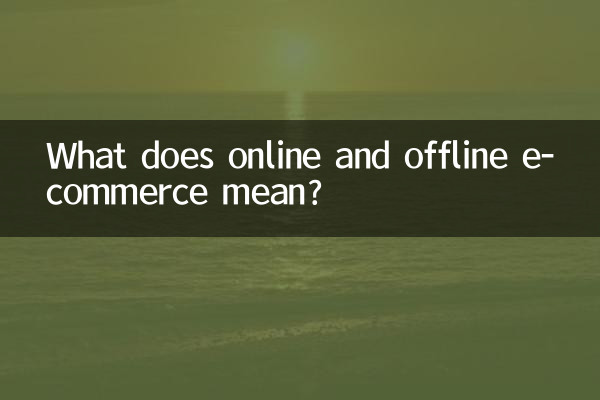What does online and offline e-commerce mean?
With the rapid development of the Internet, the e-commerce industry has become an important part of modern commerce. However, many people still have doubts about the concept of "e-commerce online and offline". This article will combine the hot topics and hot content on the Internet in the past 10 days to analyze in detail the meaning, differences and integration trends of online and offline e-commerce.
1. Definition of online and offline e-commerce

Online and offline e-commerce respectively refer to two different models of e-commerce:
| mode | definition | Features |
|---|---|---|
| Online e-commerce | Transaction of goods or services through Internet platform | No geographical restrictions, 24-hour operation, low cost |
| Offline e-commerce | Transaction of goods or services through physical stores | Strong sense of experience, high immediacy and higher trust |
2. The difference between online and offline
The following are the main differences between online e-commerce and offline e-commerce:
| Contrast Dimensions | Online e-commerce | Offline e-commerce |
|---|---|---|
| Transaction method | Completed through online platforms such as websites and APPs | Face-to-face transactions through physical stores |
| Business hours | Open 24 hours | Subject to business hours |
| cost structure | Save rent and labor costs | Rent and labor costs are higher |
| user experience | Rely on graphic, text and video display | You can experience the product on the spot |
3. The trend of online and offline integration
In recent years, online to offline integration (O2O, Online to Offline) has become an important trend in the e-commerce industry. The following are online and offline integration cases that have been hotly discussed across the Internet in the past 10 days:
| Case | Description | heat index |
|---|---|---|
| Hema | Online order + offline store experience | ★★★★★ |
| JD Daojia | Online shopping + offline instant delivery | ★★★★☆ |
| Xiaomi Home | Online marketing + offline experience store | ★★★★☆ |
4. Advantages of online and offline integration
The online and offline integration model brings the following advantages to consumers and merchants:
1.Improve user experience: Consumers can browse products online and experience them offline to achieve seamless shopping.
2.Reduce operating costs: Merchants optimize resource allocation through online traffic and offline services.
3.Expand market coverage: Combining online and offline services can reach more potential customers.
5. Future Outlook
With the advancement of technology, online and offline integration will be further deepened. For example, the application of AR/VR technology can allow consumers to obtain a more realistic shopping experience online, while big data analysis can help merchants more accurately locate target customers.
In short, the integration of online and offline e-commerce is not only an inevitable trend in industry development, but also brings more possibilities to consumers and merchants. In the future, we will see the emergence of more innovative business models, further promoting the prosperity of the e-commerce industry.

check the details

check the details